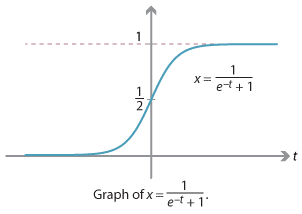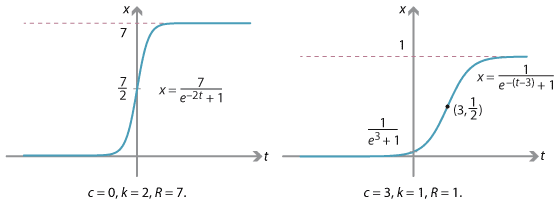Links forward
Logistic growth
We have seen many examples of exponential population growth based on an equation
\[ \dfrac{dx}{dt} = kx, \]saying intuitively that a larger population produces proportionately more offspring.
However, as we have discussed, exponential growth cannot continue forever in a finite ecosystem. There are always limits to growth. One way to model ecological constraints is by adding an extra factor corresponding to the carrying capacity \(R\) of the ecosystem:
\[ \dfrac{dx}{dt} = kx \Bigl( 1 - \dfrac{x}{R} \Bigr). \]Here \(k\) (the continuous growth rate) and \(R\) are constants. This model is called a logistic model of growth. As \(x\) increases from 0 to \(R\), the factor \(1-\dfrac{x}{R}\) decreases from 1 to 0, expressing the idea that as the population increases towards carrying capacity, growth becomes increasingly difficult; at carrying capacity, growth drops to zero.
Differential equations of this type can be solved explicitly, as we now illustrate.
Suppose there are initially 10 rabbits on an island with a carrying capacity of 1000. In the absence of ecological constraints, the rabbits reproduce with a growth rate of 2. Following the logistic model, we have
\[ \dfrac{dx}{dt} = 2 x \Bigl( 1 - \dfrac{x}{1000} \Bigr) = \dfrac{x (1000 - x)}{500}. \]Using the fact that \(\dfrac{dx}{dt} \cdot \dfrac{dt}{dx} = 1\) gives
\[ \dfrac{dt}{dx} = \dfrac{500}{x(1000 - x)}. \]In order to integrate this expression we write it in terms of partial fractions, setting
\[ \dfrac{500}{x(1000 - x)} = \dfrac{A}{x} + \dfrac{B}{1000 - x} \]and solving for \(A\) and \(B\). Cross-multiplying gives \(500 = A(1000 - x) + Bx\); so we obtain \(A = B = \dfrac{1}{2}\). Thus we can write
\[ \dfrac{dt}{dx} = \dfrac{1}{2x} + \dfrac{1}{2(1000 - x)}. \]We may antidifferentiate term-by-term to obtain
\begin{align*} t &= \dfrac{1}{2} \log_e x - \dfrac{1}{2} \log_e (1000 - x) + c \\ &= \dfrac{1}{2} \log_e \Bigl(\dfrac{x}{1000-x}\Bigr) + c, \end{align*}where \(c\) is a constant. Rearranging this equation we obtain
\[ e^{2(t-c)} = \dfrac{x}{1000-x}. \]Substituting the initial condition \(t=0\), \(x=10\) gives \(e^{-2c} = \dfrac{1}{99}\), so we have
\[ \dfrac{1}{99} e^{2t} = \dfrac{x}{1000 - x}. \]Solving now for \(x\) gives
\[ x = \dfrac{1000}{99 e^{-2t} + 1}. \]This is the desired result. As \(t\) increases towards infinity, \(e^{-2t}\) approaches 0, so the denominator approaches 1, and therefore \(x\) approaches the carrying capacity of 1000.
Using the same technique, it can be shown that the general logistic model
\[ \dfrac{dx}{dt} = kx \Bigl( 1 - \dfrac{x}{R} \Bigr), \]with \(k, R\) constants, has general solution
\[ x = \dfrac{R}{e^{-k(t-c)} + 1}, \]where \(c\) is a constant.
Exercise 10
Prove this.
Functions of this type are often called logistic functions. The simplest such function is
\[ f(t) = \dfrac{1}{e^{-t} + 1}, \]which has the following graph.
The next two graphs give further examples of logistic functions, with different values of \(k\), \(R\) and \(c\).



